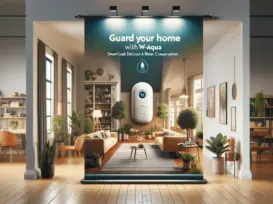Grus Home Energy - Advanced Sensor Water Leak
Revolutionizing Home Safety: The Next-Gen Advanced Sensor Technology for Water Leak Detection
Revolutionizing Home Safety: The Next-Gen Advanced Sensor Technology for Water Leak Detection
Water damage in homes and buildings can be a silent yet devastating issue, often going unnoticed until it’s too late. Traditional methods of leak detection have relied on the visible signs of water damage or manual monitoring, which can be inadequate and untimely. However, with advancements in sensor technology, a more proactive and efficient approach to tackling water leaks is now available. The next generation of advanced sensor water leak detection systems is changing the game, providing homeowners and property managers with the peace of mind that comes with around-the-clock surveillance and immediate action against potential water damage.
These sophisticated sensors utilize a combination of technologies such as ultrasonic waves, moisture detection algorithms, and environmental monitoring to identify the presence of water where it shouldn’t be. They can be installed in key areas prone to leaks, such as under sinks, near water heaters, in basements, and around appliances like washing machines and dishwashers. Once a leak is detected, the sensors can trigger an alarm, send a notification to a smartphone, or even integrate with home automation systems to shut off the water supply automatically, preventing further damage.
One of the standout features of advanced sensor water leak detectors is their ability to distinguish between different types of water presence. For example, they can differentiate a harmless change in humidity from a potentially destructive drip or flow of water. This reduces the likelihood of false alarms, a common problem with less sophisticated detectors. The use of artificial intelligence and machine learning also means that these systems can adapt and improve their detection capabilities over time, learning from each incident and enhancing their precision.
Connectivity is another key aspect of these high-tech sensors. Many are equipped with Wi-Fi or other wireless technologies, enabling them to be part of a connected home ecosystem. This interconnectivity allows for real-time alerts and the collection of data over time, which can be invaluable for understanding patterns and addressing vulnerabilities before they lead to a leak. Moreover, integration with other smart home devices extends the functionality of the sensors, creating a more cohesive and responsive home safety network.
Maintenance of these advanced sensors is another area where technology shines. With self-testing capabilities and long-lasting battery lives, they are designed to be reliable and require minimal intervention. Some models even come with additional features like temperature monitoring, which can alert homeowners to the risk of pipes freezing and bursting – a common issue in colder climates. This level of detail and foresight illustrates how sensor technology is not just reacting to problems, but anticipating them.
While the upfront cost of advanced sensor water leak detection systems may be higher than traditional methods, the potential savings from averting water damage can make them a valuable investment. Insurance companies are also beginning to recognize the benefits of these systems, with some offering reduced premiums for homes equipped with advanced leak detection technology. This is a clear indication of the trust placed in these systems to protect properties and the financial assets associated with them.
In conclusion, the advent of advanced sensor water leak detection systems represents a significant leap forward in home safety and prevention strategies. The integration of cutting-edge technology offers a robust solution to a problem that has plagued homeowners for generations. By detecting leaks early and accurately, these systems not only save on costly repairs but also preserve the structural integrity of buildings and the well-being of those inside. As smart home technology continues to evolve, we can expect these sensors to become a standard feature in the fight against water damage.
Blog, Home Safety & Risk Prevention , February 17, 2024 , Advanced Sensor Water Leak, Eco-Friendly Home Solutions, Energy Efficiency Improvements, Home Water Management System, Leak Detection Technology, Prevent Water Damage, Prevent Water Leaks, Real-Time Water Flow Monitoring, Reduce Water Bills, Smart Energy Solutions, Smart Home Water Efficiency, Smart Water Monitor, Water Conservation Solutions
©2025 All Rights Reserved. Grus IoT Co.,Ltd.
